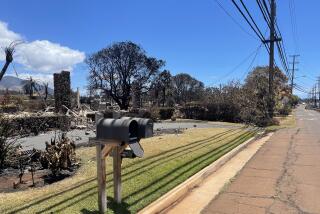How parents and teachers can calm kids’ Getty fire anxiety

During this Santa Ana wind season, 12-year-old Nicholas Ladesich tends to go to bed worrying about what might burn overnight. He often has dreams of waking up in his old house that burned down in the Woolsey fire last year.
But he awakens instead in the living room of the one-bedroom guest house he shares with his brother and parents. He demands that his mom turn on the news to monitor possible fires while his 15-year-old brother Lucas uses an app to check the strength and direction of winds.
“When he hears the wind, he goes straight to ‘there’s going to be a fire,’” Alex Aspron-Ladesich, said of her younger son. After losing their Malibu home, she said, all four family members have been diagnosed with post-traumatic stress disorder and receive counseling through a wellness center at Malibu High School run by the local Boys and Girls Club.
On Monday, the Ladesich family got the text message that Malibu schools were closed because of the Getty fire, and anxieties crested again. Lucas said it’s hard to concentrate on schoolwork amid the threat of another fire. As the one-year anniversary of the Nov. 8 Woolsey fire approaches, the Santa Anas, the fires and falling ash are bringing back bad memories.
Across the state, families have fled fires in the dark of night amid howling winds; thousands have huddled in evacuation centers, their cars packed with valuables. It smells like smoke, and ash drifts through the air. School days are canceled, routines disrupted and children are suffering mentally — even if they’re not physically at risk from a fire, mental health counselors and parents said.
“I can see an uneasiness in their daily living. [It’s a] concern that comes up when we hear there’s going to be Santa Ana winds. That’s our main red flag,” Aspron-Ladesich said of her sons.
During the Saddleridge fire in the San Fernando Valley earlier this month, Cleveland High humanities magnet coordinator Jennifer Macon wore a mask while she directed traffic as parents rushed to pick up their children. Amidst the logistical confusion, Macon said, she saw the mental health effects among students.
Students, she said, were experiencing panic attacks. On a day with teachers absent, heavy smoke and pervasive fear, three students stayed in her office because they just couldn’t handle the stress on campus, she said.
“Coming into the day I didn’t anticipate that,” Macon said.
School healthcare workers said the increase in destructive annual wildfires comes at a time when anxiety among young people is more prevalent than in the past.
In a nationwide 2018 Pew Research Center survey of teens ages 13 to 17, 70% of respondents said anxiety and depression were major problems “among people their age in the community where they live.” And more than 1 in 3 girls and 1 in 5 boys said they “feel tense or nervous about their days” every day or almost every day.
“The last five-10 [years] we’ve seen a huge spike in anxiety ... and it’s hard to say exactly why,” said Shuli Lotan, the mental health counseling coordinator for Santa Monica-Malibu Unified School District.
Wildfire stress can compound existing feelings of anxiety involving social media pressures, fears about immigration and school shootings for instance, Lotan said.
“It’s very debilitating to think ‘What’s next? What’s my safety plan? ... Are my parents going to come home safe?’” said Pia Escudero, head of student health and human services for Los Angeles Unified School District. “It’s not sustainable for us to be in this fight or flight stage for long periods of time.”
Students are also reminded of the fire when they return to school. Though the smoke may have cleared, it can take a while to clean air conditioning systems. The activities they rely on for exercise and sometimes stress relief can be canceled.
Palisades Charter High School has had multiple school closures this month from two fires.
Maya Deganyar, 15, a sophomore at Palisades Charter High, said closures and evacuations have disrupted study, exam and assignment schedules. At the outdoor campus, students can smell smoke between classes.
Her swim practices were canceled at least four times in the last two weeks due to poor air quality. And when she has gone swimming, she’s come back with a runny nose and watery eyes, her mother said.
Advice for parents and teachers during and after fires
At L.A. Unified, Escudero encourages teachers and parents to take a “psychological first aid” approach to helping children cope with fires, keeping five main elements in mind:
- Listen. “This is not really a time for adults to really talk at children,” Escudero said. Instead, adults should ask if they have questions or concerns — and listen and answer those questions in a developmentally appropriate way, reinforcing their safety.
- Protect. “Protect them from additional stressors,” Escudero said. That can mean turning off the TV to help make the home a safe and calming space.
- Connect. This can be a good time to overcome mental health stigmas and connect students or families to a mental health worker or specialist if they are experiencing symptoms, Escudero said.
- Model. ”Really model calm, really be there, if it’s something that we need to react to, react in the best way that we can,” Escudero said. This means that adults also need to address their own mental health needs.
- Teach. This can be an opportunity to teach about safety, your family’s disaster plan and the importance of maintaining mental health, Escudero said. Teaching children resilience involves helping them understand how to cope with adverse situations in a healthy way — how to problem-solve, self-regulate, use tools such as grounding or mindfulness to prevent panic, Lotan said.
How to recognize age-appropriate signs of anxiety
Lotan said these are some of the signs adults should pay attention to and seek help if they persist:
- Preschoolers: behavioral regression such as thumb-sucking, withdrawal from friends and family or clinginess.
- Elementary school-age children: separation anxiety, nightmares, trying to avoid school or activities they usually like, trouble concentrating, physical complaints such as headaches and stomachaches without a case.
- Adolescents and teenagers: increases in conflict, problems with concentration. Post-traumatic stress disorder “is actually a lot more rare than people realize ... but trauma can show up like depression, like anxiety,” Lotan said.
The National Child Traumatic Stress Network has additional resources for talking to children of different ages before, during and after fires.
More to Read
Start your day right
Sign up for Essential California for news, features and recommendations from the L.A. Times and beyond in your inbox six days a week.
You may occasionally receive promotional content from the Los Angeles Times.








